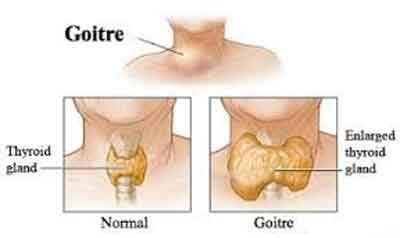- Home
- Editorial
- News
- Practice Guidelines
- Anesthesiology Guidelines
- Cancer Guidelines
- Cardiac Sciences Guidelines
- Critical Care Guidelines
- Dentistry Guidelines
- Dermatology Guidelines
- Diabetes and Endo Guidelines
- Diagnostics Guidelines
- ENT Guidelines
- Featured Practice Guidelines
- Gastroenterology Guidelines
- Geriatrics Guidelines
- Medicine Guidelines
- Nephrology Guidelines
- Neurosciences Guidelines
- Obs and Gynae Guidelines
- Ophthalmology Guidelines
- Orthopaedics Guidelines
- Paediatrics Guidelines
- Psychiatry Guidelines
- Pulmonology Guidelines
- Radiology Guidelines
- Surgery Guidelines
- Urology Guidelines
Goitre - Standard Treatment Guidelines

A goiter or goitre (Latin gutteria, struma), is a swelling in the thyroid gland which can lead to a swelling of the neck or larynx (voice box). Goitre rarely occurs when the thyroid gland is functioning properly. Worldwide, over 90% cases of goitre are caused by iodine deficiency.
Ministry of Health and Family Welfare, Government of India has issued the Standard Treatment Guidelines for Goitre. Following are the major recommendations:
Classification :
They can be classified in several ways by morphology, appearance, cause and other characteristics.
Non-Toxic:
1. Simple (struma diffuse)
2. Multinodular (struma nodosa)
3. Uninodular (struma uninodosa)
Toxic:
1. Diffuse (Graves)
2. Toxic multinodular
3. Toxic nodule
Special:
1. Cancer
2. Thyroiditides
3. Inflammatory
Various causes:
1. Chronic infection
2. Actinomycosis
3. Amyloidosis
Other type of classification:
1. Class I - palpation struma - in normal posture of the head, it cannot be seen; it is only found by palpation.
2. Class II - the struma is palpative and can be easily seen.
3. Class III - the struma is very large and is retrosternal; pressure results in compression marks.
Causes :
Worldwide, the most common cause for goiter is iodine deficiency. Selenium deficiency is also considered a contributing factor. In countries that use iodized salt, Hashimoto's thyroiditis is the most common cause.
Further causes include
1. thyroid autonomy
2. autoimmune conditions of the thyroid (Hashimoto thyroiditis, Morbus Basedow)
3. medications and substances such as lithium, antithyroid agents, thyocyanate
4. inflammations (thyroiditis)
5. cysts
6. benign and malignant neoplasms
7. pituitary problems
8. acromegaly
9. thyroid hormone insenstitvity
10. sarcoidosis, amyloidosis
11. hydatiform mole
Signs and symptoms :
Goiter associated with hypothyroidism or hyperthyroidism may present with symptoms of the underlying disorder although the symptoms are often unspecific and hard to diagnose.
Goiter not associated with hormonal abnormalities will not cause any symptoms aside from the presence of anterior neck mass. However, for particularly large masses, compression of the local structures may result in difficulty in breathing or swallowing. In those presenting with these symptoms, malignancy must be considered.
Toxic goiters will present with symptoms of thyrotoxicosis such as palpitations, hyperactivity, weight loss despite increased appetite, and heat intolerance.
Treatment :
Goiter caused by suspected iodine deficiency is very frequently treated by a combination of levothyroxine and iodine supplementation depending on thyroid hormone levels.
Treatment may not be necessary if the goiter is small. Goiter may be related to hyper- and hypothyroidism (especially Graves' disease) and may be reversed by treatment. Graves' disease can be corrected with antithyroid drugs (such as propylthiouracil and methimazole), thyroidectomy (surgical removal of the thyroid gland), and iodine-131 ( 131I - a radioactive isotope of iodine that is absorbed by the thyroid gland and destroys it). Hypothyroidism may raise the risk of goiter because it usually increases the production of TRH and TSH. Levothyroxine, used to treat hypothyroidism, can also be used in euthyroid patients for the treatment of goitre. Levothyroxine suppressive therapy decreases the production of TRH and TSH and may reduce goiter, thyroid nodules, and thyroid cancer. Blood tests are needed to ensure that TSH is still in range and the patient has not become subclinically hyperthyroid. If TSH levels are not carefully monitored and allowed to remain far below the lower limits of normal (below 0.1 mIU/L or IU/mL), there is epidemiologic evidence that levothyroxine may increase the risk of osteoporosis and both hip and spinal fractures.[4] (Such low levels are therefore not intentionally produced for long periods, except occasionally in the treatment of TSH-dependent thyroid cancers.)
Thyroidectomy with 131I may be necessary in euthyroid goitrous patients who do not respond to levothyroxine treatment, especially if the patients have difficulty breathing or swallowing. 131I, with or without the pre-injection of synthetic TSH, can relieve obstruction and reduce the size of the goitre by thirty to sixty-five percent. Depending on how large the goitre is and how much of the thyroid gland must be removed or destroyed, thyroidectomy and/or 131I treatment may destroy enough thyroid tissue as to produce hypothyroidism, requiring life-long treatment with thyroid hormone pills.
Guidelines by The Ministry of Health and Family Welfare :
Dr J M Hans Ex-HOD Dept. of Otorhinolaryngology Dr.RML Hospital New Delhi

Disclaimer: This site is primarily intended for healthcare professionals. Any content/information on this website does not replace the advice of medical and/or health professionals and should not be construed as medical/diagnostic advice/endorsement or prescription. Use of this site is subject to our terms of use, privacy policy, advertisement policy. © 2020 Minerva Medical Treatment Pvt Ltd